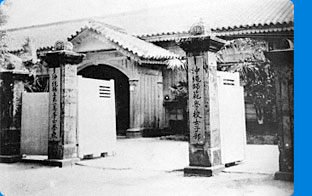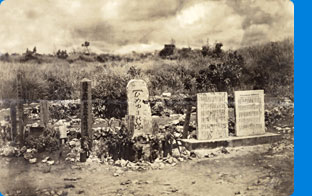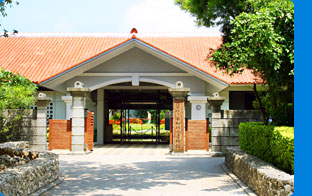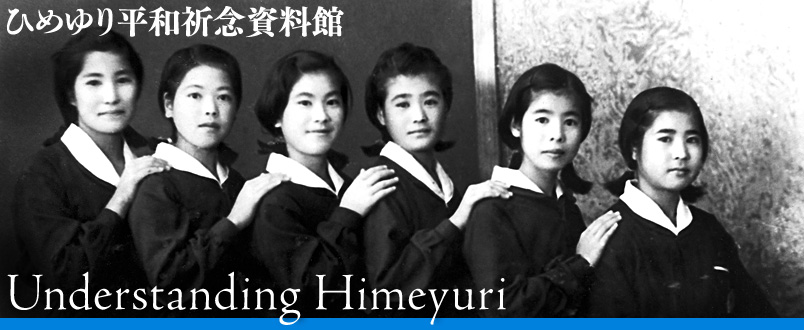
In
April 1945 (Showa 20), when the Second World War was almost coming to a
close, a fierce battle was being unleashed on Okinawa, with U.S. forces
landing on the island. Male and female students at 21 secondary schools
in Okinawa at the time were mobilized for the war effort and sent to
the battlefield. The female students were between the ages of 15 and 19
and mainly worked as nurses in places such as the Army Field Hospital.
The male students were from 14 to 19 years of age, and the upper-grade
students were organized into so-called "Blood and Iron Loyalist Student
Corps" (in charge of transportation of supplies, repair of bridges,
etc.), while the lower-grade students were formed into the "Signal
Corps" (in charge of repair of electric cables, distribution of
telegraphs, etc.).
In those days, two girls' schools, the Female Division of Okinawa
Normal School and the Okinawa First Girls' High School stood in what is
now the Asato district of Naha City. From these schools, 222 students
and 18 teachers were mobilized to the Okinawa Army Field Hospital in what
is now Haebaru Town. As a result, 136 of them lost their lives. After
the war, the group of students and teachers who were mobilized from the
two girls' schools came to be called the "Himeyuri Student Corps."

 The
Okinawa Female Normal School was a school for training future teachers.
The duration of study was five years, consisting of a three-year
preparatory course and a two-year regular course. There were two paths
for admittance to this school. First, students could have completed
their study in the National Elementary School and the Advanced Course
in the National Elementary School and then begun the preparatory course
at the school after taking an exam. Alternatively, if the students were
graduates from a women's high school, they had to take an exam to be
enrolled in the regular course.
The
Okinawa Female Normal School was a school for training future teachers.
The duration of study was five years, consisting of a three-year
preparatory course and a two-year regular course. There were two paths
for admittance to this school. First, students could have completed
their study in the National Elementary School and the Advanced Course
in the National Elementary School and then begun the preparatory course
at the school after taking an exam. Alternatively, if the students were
graduates from a women's high school, they had to take an exam to be
enrolled in the regular course.
The Okinawa First Girls' High School was founded with the motto, "Aim
for the Development of Highly Intellectual and Well-Cultivated Women."
The required period of study at this school was four years. Students
entered after completing their National Elementary School education and
passing the entrance exam.
For financial reasons, both schools were set up as annexes to each
other in 1916 (Taisho 5) and began to share the same school facilities.
The students came to study under the same teachers, and it looked as
though the schools had a siste-school relationship. The school
premises had an area of 800 tsubo, containing an auditorium, a gym, a
library, a farm, an alumni hall, a dormitory, and a swimming pool, the
last of which was the only one that existed in Okinawa at that time.
Students joined the school from all over Okinawa after winning a very
intense competition. In a favorable educational environment, the
students enjoyed very pleasant school days. However, as the battle of
Okinawa unfolded, the schools also became a target of U.S. bombardment;
the buildings were razed to the ground, forcing the closure of the
schools.
*The Origin of the Name "Himeyuri"
Both
the Okinawa Female Normal School and the Okinawa First Girls' High
School had their own school magazines. The one at the First High School
was named "Otohime" (young ladies), and the other at the Normal School
was called "Shirayuri" (white lilies). After the two schools began to
operate side by side, the magazines were also unified, and the new
version was named "Himeyuri." It was only after the war that the word
"Himeryuri" came to be regularly written in Japanese hiragana letters.
 In
January 1946, the year following the end of the Battle of Okinawa, the
U.S. forces ordered people living in the former Mawashi Village (the
present Mawashi district in Naha City) to relocate to what is now
Komesu, Itoman City. The then Mayor of Mawashi Village was Mr. Washin
Kinjo, who was also a relative of a Himeyuri Corps student who died in
the battle. Upon appeal from Mr. Kinjo, the villagers of Mawashi began
collecting the remains of the war dead, and in February, they erected
the "Konpaku-no-tô" (monument to the spirits of the deceased) as a
vault for these remains. This was the first memorial for the war dead
to be built after the war.
In
January 1946, the year following the end of the Battle of Okinawa, the
U.S. forces ordered people living in the former Mawashi Village (the
present Mawashi district in Naha City) to relocate to what is now
Komesu, Itoman City. The then Mayor of Mawashi Village was Mr. Washin
Kinjo, who was also a relative of a Himeyuri Corps student who died in
the battle. Upon appeal from Mr. Kinjo, the villagers of Mawashi began
collecting the remains of the war dead, and in February, they erected
the "Konpaku-no-tô" (monument to the spirits of the deceased) as a
vault for these remains. This was the first memorial for the war dead
to be built after the war.
On April 5th of the same year, the villagers erected "Himeyuri-no-tô,"
or the Himeyuri Cenotaph, at the site where the Ihara Third Surgical
Cave used to be located. Many Himeyuri Corps students and workers at
the Army Field Hospital are known to have lost their lives in that
cave. On April 7, two days after the erection of the Cenotaph, the
first spirit-consoling service for the deceased was conducted. At the
ceremony, Mr. Seizen Nakasone, who was one of the teachers accompanying
the student Corps, dedicated the following poem to those who fell
during the Battle: "Heads pillowed on rock / That is hard / May you
rest in peace / Our schoolmates."
On April 9th, another monument, "Kenji-no-tô" (monument to the stalwart
boys) was built in Mabuni in honor of the male students who had been
victims of the war. These three monuments, Konpaku, Himeyuri, and
Kenji, are the memorials that were erected to express our strong desire
for lasting peace.

The Okinawa Female Normal School and the Okinawa First Girls' High School were both destroyed in the Battle of Okinawa and closed down. However, shortly after the war, the graduates of the schools reestablished their alumnae association. The association was named "Himeyuri Alumnae" after the title of their prewar school magazine. In 1960, when Okinawan life was beginning to acquire some normalcy, the association was authorized to become a legally incorporated foundation, and since then it has been taking a part in many activities as the "Himeyuri Alumnae Incorporated Foundation." Some of its great achievements as a legally incorporated foundation include the institution of the "Himeyuri Alumni Scholarship Fund" as well as the establishment of the "Himeyuri Peace Museum." By 2010, scholarships had been granted to 29 female students over a period of 27 years, and the Peace Museum has engaged in various activities to send out messages of peace since its opening.
 It
had been the Himeyuri Alumnae's strong wish to establish a memorial
museum that would preserve and exhibit materials related to the
Himeyuri Student Corps and convey the tragedy of war to future
generations. Thus, in January 1983, the Himeyuri Alumnae Incorporated
Foundation set up an organization to facilitate the establishment of
the museum. The preparatory work for its foundation consisted of
selection of an appropriate site, fund-raising through charities, and
decision-making concerning the exhibition materials. On June 23rd, the
"Himeyuri Peace Museum" was finally opened adjacent to the Himeyuri
Cenotaph. Mr. Seizen Nakasone, who was a teacher accompanying the
student corps during the war, became the first director of the museum.
It
had been the Himeyuri Alumnae's strong wish to establish a memorial
museum that would preserve and exhibit materials related to the
Himeyuri Student Corps and convey the tragedy of war to future
generations. Thus, in January 1983, the Himeyuri Alumnae Incorporated
Foundation set up an organization to facilitate the establishment of
the museum. The preparatory work for its foundation consisted of
selection of an appropriate site, fund-raising through charities, and
decision-making concerning the exhibition materials. On June 23rd, the
"Himeyuri Peace Museum" was finally opened adjacent to the Himeyuri
Cenotaph. Mr. Seizen Nakasone, who was a teacher accompanying the
student corps during the war, became the first director of the museum.
The museum buildings resemble those of the Okinawa Female Normal School
and the First Girls' High School in the past. The beautiful flower
garden in the courtyard is dedicated to the souls of the girls who lost
their precious lives on the battlefield. Since the number of survivors
from the war is decreasing each year, it was thought essential to
relate the realities of war in a way that is more accessible to younger
generations. For this purpose, the museum carried out extensive
alterations of the exhibitions in 2004. Moreover, a new extension, "The
6th Exhibition Room: The Passage to Peace," was created with a view to
passing on our wishes for peace to future generations.
[1896]
Girls' Courses (later Okinawa Female Normal School, commonly called "Joshi") were established at the Normal School in Shuri.
[1900]
Okinawa Private High School for Women (later Okinawa First Girls' High School, commonly called "Ichikôjo") was founded.
[1916]
"Joshi" and "Ichikôjo" were set up as annexes to each other.
[1927]
The school magazines of "Joshi" and "Ichikôjo" were combined into a new magazine and began to be circulated as "Himeyuri."
[1945]
The Battle of Okinawa
The buildings of the Okinawa Female Normal School and Okinawa First Girls' High School were reduced to ashes in the battle. Both schools were closed down.
[1946]
Erection of the Himeyuri Cenotaph. The first spirit-consoling service for the Himeyuri students was conducted.
Erection of a monument inscribed with Seizen Nakasone's poem, "Iwamakura" ("Rocky Pillow").
[1948]
The Himeyuri Alumnae Association was reestablished. The alumnae began their effort to secure a site for the construction of an alumnae hall.
[1951]
Mr. Shinichi Gima, a second-generation Okinawan American in Hawaii, donated funds for the purchase of land for the construction of the Himeyuri Cenotaph.
Publication of the book Okinawa's Tragedy—Memoirs of the Himeyuri Students by Seizen Nakasone.
[1953]
The movie "The Himeyuri Cenotaph" was released in theaters.
[1960]
"The Himeyuri Alumnae Association" was granted the status of a legally incorporated foundation.
[1968]
The Alumnae Hall was constructed.
[1972]
Okinawa's reversion to Japan.
[1982]
The Himeyuri Alumnae Association agreed on the construction of a "Himeyuri Memorial Museum" during its general assembly.
[1983]
The Okinawa Human Resources Development Foundation was entrusted with the alumnae fund. The Himeyuri Alumnae Association Scholarship Fund was established.
[1989]
The Himeyuri Peace Museum was opened.
[1990]
The first anniversary of the opening of the Museum. The exhibition "Himeyuri Youth" was held.
[1991]
The second anniversary event "Visiting the Old Battlefields—The Footprints of the Himeyuri Student Corps" was held. (This yearly event was held for six years).
[1994]
A roundtable discussion, "How to relate the virtues of peace to the next generations," was held in commemoration of the fifth anniversary of the museum.
The fifth anniversary film Prayers for Peace—Testimonies of the Himeyuri Students was created and shown to the public.
[1995]
50th anniversary of the end of the Pacific War
Seizen Nakasone, Director of the Museum, passed away.
50th postwar memorial service for the deceased Himeyuri students was held.
[1999]
Commemoration of the tenth anniversary of the Museum with a "Prayer-for-Peace Concert."
A special exhibition, "All the Students in the Battle of Okinawa," was also held in commemoration of the anniversary.
[2001]
Themed exhibition "Seizen Nakasone—Life of Purification of Souls."
[2002]
Erection of a monument to mark the former site of "Joshi" and "Ichikôjo."
[2003]
Themed exhibition "Himeyuri Students' Life After the War."
[2004]
Extensive alteration of the exhibitions.
[2005]
Themed exhibition "The Nurses at the Okinawa Army Field Hospital and their Battle of Okinawa."
The 60th anniversary of the end of the Pacific War. A public reading was organized with the theme "Prayer for Peace—Messages from the Himeyuris."



